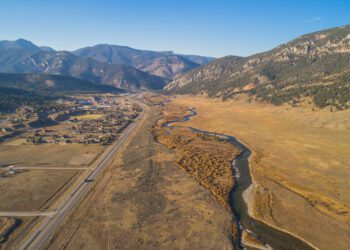By Jonathan Thompson WRITERS ON THE RANGE
Ever since 1790, when the U.S. Census started keeping track of such things, the migratory flow of non-Indigenous people within the United States has moved from East to West, into lands they erroneously saw as a blank slate, and not so erroneously as a land rife with natural resources to exploit.
Americans are still mobile and still moving West, but over time, the trajectory of the human flow has shifted to something more complex, with shifting patterns that sometimes double back unexpectedly. It’s a sign of changing economics, but also, perhaps, one of a maturing region.
During the 19th century the federal government lured colonizers West with vast land giveaways. The masses came seeking what Frederick Jackson Turner called “the richest free gift that was ever spread out before civilized man.” Erasing from view the peoples who had lived on the land for millennia, he described the West as “vacant”—an irresistible “opportunity for a new order of things.”
Later, during the Dust Bowl and Great Depression, hundreds of thousands of people flocked from the lower Midwest to California, seeking refuge from drought and economic distress. The trend continued after World War II, as a wave of returning soldiers and their families moved westward for opportunities in the growing cities of the region, along with the oil and gas booms and the uranium frenzy and then the big coal-power buildup on the Colorado Plateau.
Those same trends continue in many parts of the West, but over the last few years, some of the same migration-magnet counties of the past have seen a greater number of people leave—often for other parts of the region—than move in.
Take Farmington in northwestern New Mexico. Once a quiet agricultural town, a succession of energy-related booms beginning in mid-century drew droves of job- and opportunity-seekers to it from all over the nation. The population of the county ballooned from just 18,000 in 1950, to 130,000 sixty years later. But when natural gas prices plummeted at the end of 2008, the main pillar of the economy crumbled. Energy workers followed the drilling rigs to more lucrative oil patches, and the population started shrinking and continues to do so today as the coal industry also erodes away.
The pattern—of as much as eight percent of the population moving away—is repeated in other natural gas and coal-dependent counties, including Sublette and Campbell counties in Wyoming, Rio Blanco County in Colorado and Uintah County in Utah.
Drill rigs and draglines—or the lack thereof—are not the only factors driving migratory movement in the West. Denver, which once housed enough energy executives to inspire the Dynasty television series, still attracts migrants, only this time they are millennials coming to take advantage of high-wage jobs, a growing marijuana economy and recreational and cultural amenities. On the other hand, the population continues to drain from some of the agricultural, non-resort counties of Colorado and every other state in the West.
Meanwhile, in California, the exodus is outpacing the influx, with Los Angeles County losing about 30,000 people a year and the state of California some 200,000 per year. Many of them are equity refugees—cashing out of the inflated California real estate market and putting their money into places like Maricopa County, Arizona, home of Phoenix. It’s one of the nation’s fastest-growing places, despite this July experiencing the city’s hottest month in the past 125 years.
Relatively reasonable housing costs in Phoenix and a revitalized downtown remain a draw, and energy-intensive air conditioning, for those who can afford it, helps offset the brutal temperatures —even as it helps trigger them.
Yet another pattern-shift is upon us, as urbanites and telecommuters flee from the pandemic or social unrest to smaller, more affordable “Zoom towns” and rural areas. Although coronavirus-era migration data has not yet been released, the real estate brokerage Redfin reports that, after taking a dip this spring, the rural real estate market nationwide has taken off much faster than in urban areas.
Amenity-rich, rural places like Chaffee County, Colorado, or Bonner County, Idaho, have seen noticeable spikes in median home prices and home sales over the last few months. Whether this represents a wave of second-home buyers looking for a part-time refuge or people looking to permanently relocate is not clear. But it may signal a new wave of urban migrants crashing into the suburban and rural West once again. You could even call them COVID migrants.
Jonathan Thompson is a contributor to Writers on the Range, writersontherange.org, a nonprofit dedicated to spurring lively conversation about the West. He’s a veteran reporter on the West and the author of “River of Lost Souls: The Science, Politics, and Greed Behind the Gold King Mine Disaster.”











